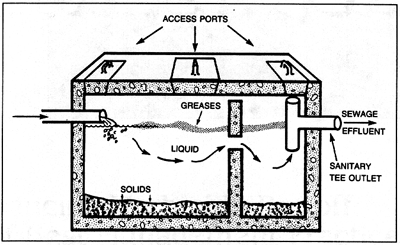How does a septic tank work …it’s basically pretty simple.
A septic tank generally is made up of a tank of between 1,000 and 2,000 gallons or 4000 and 8000 liters that is attached by an inlet waste water pipe at one end and outlet pipe to a sewage leach field at the other end. Generally speaking, these pipe connections are created underground allowing liquid to enter and exit without disturbing the surface layer of the surrounding terrain.
A septic tank usually incorporates two chambers which are separated by a dividing wall that has openings located about midway between the ground and roof of the tank. Your septic tank is a key component of the your septic system which is a basically just a small-scale sewage treatment plant. They are quite common in rural areas where is no way to connect to main sewage lines that are provided by local governments.

The term “septic” refers to the bacterial environment that develops in the tank which decomposes the waste that enters the tank from the inlet pipe attached to it. A percolation soil test is required to determine the location the tank is to placed and if the soil is suitable to handle a septic drain field. This test is usually performed by the municipality or by the local government health department the septic tank is to be located in.
HOW A SEPTIC TANK WORKS:
Waste water and waste material enters the first chamber of the tank from the inlet pipe that is attached to the septic tank. This allows the solids to settle and scum to float in the waste water. The solids that have settled are anaerobically digested, there by reducing their volume.The liquid scum flows through the opening in the dividing wall to the second chamber, where further settlement occurs, while the extra waste water which is in a relatively clear condition flows through the outlet into the drainage field.
Waste that is not decomposed by the bacterial digestion process will eventually need to be removed from the tank by a septic tank clean out service company. If this process is not done the septic tank will overflow and raw sewage may discharge and clog the drain field piping and this could end in expensive repairs that would have to be made and there may also be environmental issues that will have to be dealt with.
A properly maintained septic tank system can last for decades if you follow basic guidelines that will help keep your system balanced and operating efficiently.
